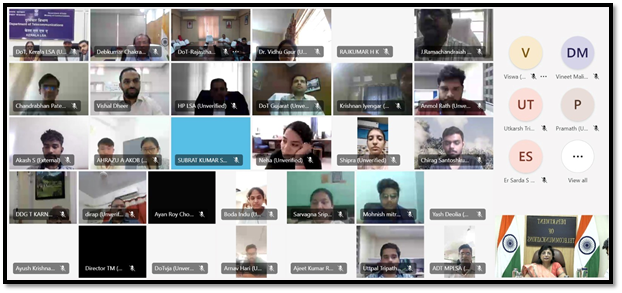Department of Telecommunications (DoT), in collaboration with National Telecommunications Institute, Ghaziabad (NTIPRIT) conducted an Awareness Workshop for Sanchar Mitras today on May 28, 2024. Under Sanchar Mitra programme, students are engaged as volunteers to empower citizens with respect to their safe & smooth journey in digital world, by raising awareness about various citizen centric services of Department and dangers of cyber fraud.

Smt Madhu Arora, Member (T), Digital Communication Commission, addressing Sanchar Mitras during the workshop
The Sanchar Mitra have been selected from the students of the prestigious educational institutions which are housing 100 5G Use Case Labs. Over 250 Sanchar Mitras, the student volunteers, have been selected across India.

220+ Sanchar Mitras from 20+ States/UTs participated in the workshop
Smt Madhu Arora, Member (T), Digital Communication Commission, interacted with Sanchar Mitras during the inauguration of the workshop. She said, “Telecommunications plays a vital role in today’s digital world. It is imperative that the citizens are aware of today’s digital trends and developments, thus, Sanchar Mitra is a steppingstone of our efforts to raise awareness and empower citizens.”
She further described them as ‘agents of change’ in our society, helping bridge the gap between Department’s initiatives and the citizens these initiatives intend to serve, particularly in remote areas where access to information is limited. Member (T) spoke on the importance of two-way communication with focus on Sanchar Mitra as a feedback mechanism, relaying valuable insights regarding challenges faced by citizens to DoT to help department form better strategies. She urged them to make use of this unique platform to unlock future opportunities in telecom and related fields.
She lauded the efforts of DoT in ensuring citizen safety in times of natural disasters and through innovative solutions like Sanchar Saathi. India’s technological manufacturing prowess was also highlighted with the milestone of creating an 4G & 5G indigenous stack appreciated during the workshop.
Shri Deb Kumar Chakraborti, Director General, NTIPRIT, emphasised on the role of Sanchar Mitra in bridging the communication gap between citizens and DoT. He enlisted providing affordable connectivity for all, grievance redressal, tackling cyber threats, safe citizen centric solutions, as the primary duties of DoT. DG (NTIPRIT) gave valuable suggestions on the expansion of Sanchar Mitra programme.

Shri Deb Kumar Chakraborti, Director General, NTIPRIT addressing the Sanchar Mitras during the workshop
The roles of Sanchar Mitras in this programme will be multi-fold: They will play an instrumental role from raising awareness on various telecom related citizen centric services like Sanchar Saathi, promoting digital literacy, and educating on dangers of cyber fraud; to reporting of issues, collecting feedback and coordination with field offices.
The workshop organized by NTIPRIT for Sanchar Mitra acted as an induction programme, enhancing the capacity/understanding and effectiveness of volunteers. Aimed at the holistic awareness of telecom issues, the interactive workshop focussed on communication skills and provided an overview-cum-demonstration of key citizen-centric services.
Background-Sanchar Mitra Programme
Sanchar Mitras are the students identified from universities to whom 100 5G use case labs have been awarded. This spreads over educational institutions across 28 states and 4 UTs.
The Sanchar Mitra programme aims to enhance mobile users’ security; clarity on radiation myths; raise awareness about DoT’s initiatives and prevent mobile-related fraud. As citizen support enhances the efficacy of efforts of the department, the engagement of Sanchar Mitra from different states shall have a valuable addition to the department’s efforts to enhance mobile users’ security, raise awareness about DoT’s initiative and promote a safe digital ecosystem.
The programme seeks to establish a bridge between the DoT and citizens, fostering a collaborative approach towards telecom and Sanchar issues.
Roles of Sanchar Mitra:
- Awareness to be conducted on broad citizen centric services like Sanchar Saathi portal, Tarang Sanchar portal for EMF awareness, Toll Free Numbers to report international numbers with local numbers, spam and suspected fraud communication, etc.
- Wider outreach and awareness at grassroot level in their native languages establishing a more relatable and effective connection with citizens, thereby increasing the initiative’s impact. They shall be coordinating with Colleges, NGOs, Village Level Entrepreneurs etc for the same
- Reporting and Escalation- Volunteers will act as a link between citizens and the Department of Telecommunications. They will assist citizens in reporting forged or fake mobile connections, lost devices, and other related issues. Volunteers can help citizens navigate the Sanchar Saathi portal and escalate cases to the appropriate authorities when required.
- Coordination with Field Offices and State Police: Volunteers will play a pivotal role in coordinating with the Department’s field offices and local law enforcement agencies. They can assist in verifying information, providing necessary documentation, and facilitating a smoother collaboration to address cases of fraud or misuse effectively.
- Data Collection and Insights: Volunteers can gather valuable insights about local trends and challenges related to mobile security. This data can help the Department tailor its strategies and policies to address specific issues faced by different states and communities.
- Feedback Mechanism: Volunteers can act as a feedback mechanism, relaying citizens’ concerns, suggestions, and experiences back to the Department. This ongoing feedback loop can aid in refining the Sanchar Saathi initiative and adapting it to evolving needs.

Comments are closed.